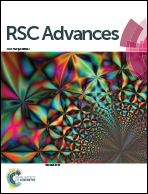Simultaneous immobilization of a matrix containing palladium and phase transfer catalyst on silica nanoparticles: application as a recoverable catalyst for the Heck reaction in neat water†
Abstract
Simultaneous covalent anchoring of a phosphonium–palladium complex/phase transfer catalyst matrix on the surface of silica nanoparticles and the application of the resulting catalyst in the Heck reaction of a variety of different haloarenes in neat aqueous media is described.


 Please wait while we load your content...
Please wait while we load your content...